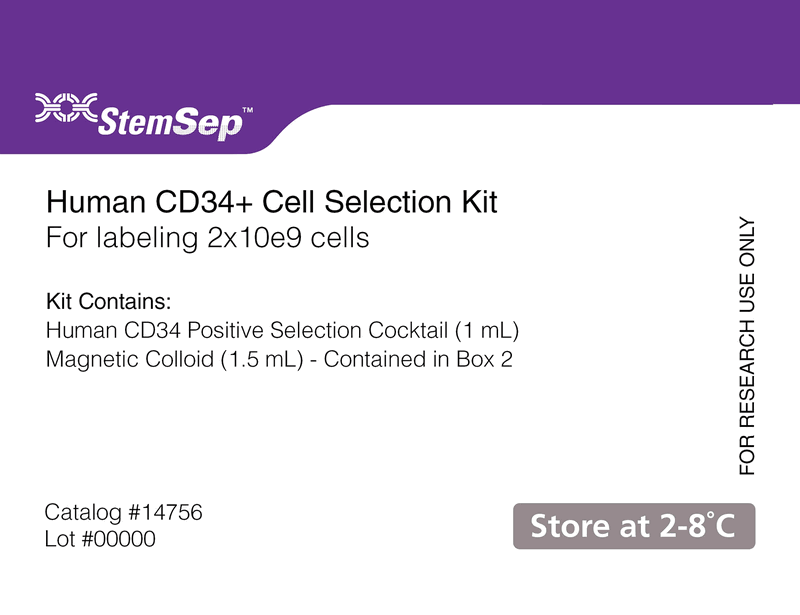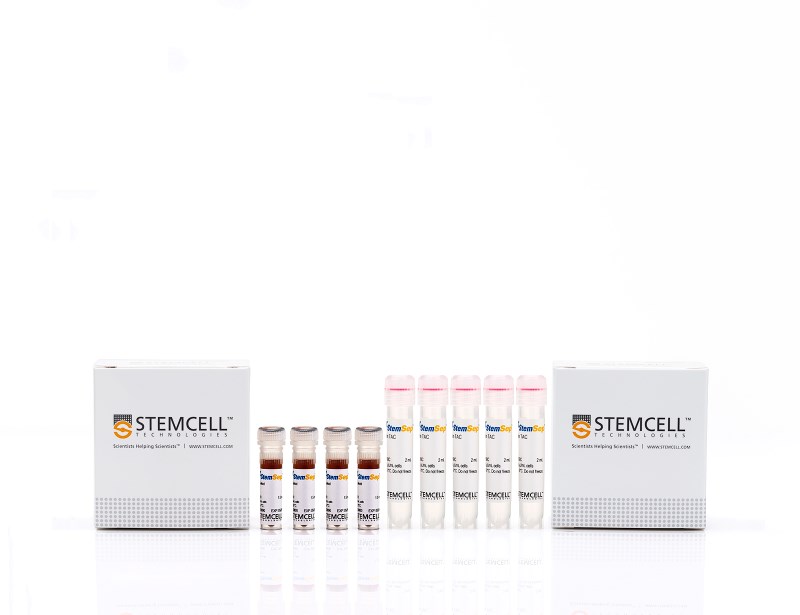StemSep™ Human CD34 Positive Selection Cocktail
Immunomagnetic column-based positive selection kit
概要
The StemSep™ Human CD34 Positive Selection Cocktail is designed to isolate CD34+ cells from fresh or previously frozen bone marrow, cord blood, or mobilized peripheral blood mononuclear cells by positive selection. Desired cells are targeted with Tetrameric Antibody Complexes recognizing CD34 and dextran-coated magnetic particles. The cocktail also contains an antibody to human Fc receptor to minimize nonspecific binding. Labeled cells are then separated using StemSep™ Columns and Magnets. The CD34 antigen is expressed on hematopoietic stem and progenitor cells.
Components
- StemSep™ Human CD34 Positive Selection Cocktail (Catalog #14756)
- StemSep™ Human CD34 Selection Cocktail, 1 mL
- StemSep™ Magnetic Colloid, 1.5 mL
- StemSep™ Human CD34 Positive Selection Cocktail (Catalog #14766)
- StemSep™ Human CD34 Selection Cocktail, 5 x 1 mL
- StemSep™ Magnetic Colloid, 4 x 1.5 mL
Magnet Compatibility
• StemSep™ Magnet (Catalog #11030, 11050, 11060 11070) or a magnet with the strength of at least 0.6 Tesla
• Commercially available positive selection columns
Subtype
Cell Isolation Kits
Cell Type
Hematopoietic Stem and Progenitor Cells
Species
Human
Sample Source
Bone Marrow, Cord Blood, PBMC
Selection Method
Positive
Application
Cell Isolation
Brand
StemSep
Area of Interest
Immunology, Stem Cell Biology
技术资料
| Document Type | 产品名称 | Catalog # | Lot # | 语言 |
|---|---|---|---|---|
| Product Information Sheet | StemSep™ Human CD34 Positive Selection Cocktail | 14756 | All | English |
| Manual | StemSep™ Human CD34 Positive Selection Cocktail | 14756 | All | English |
| Safety Data Sheet 1 | StemSep™ Human CD34 Positive Selection Cocktail | 14756, 14766 | All | English |
| Safety Data Sheet 2 | StemSep™ Human CD34 Positive Selection Cocktail | 14756, 14766 | All | English |
数据及文献
Publications (1)
Cancer research 2011 FEB BCR/ABL stimulates WRN to promote survival and genomic instability.
Abstract
Abstract
BCR/ABL-transformed chronic myeloid leukemia (CML) cells accumulate numerous DNA double-strand breaks (DSB) induced by reactive oxygen species (ROS) and genotoxic agents. To repair these lesions BCR/ABL stimulate unfaithful DSB repair pathways, homologous recombination repair (HRR), nonhomologous end-joining (NHEJ), and single-strand annealing (SSA). Here, we show that BCR/ABL enhances the expression and increase nuclear localization of WRN (mutated in Werner syndrome), which is required for processing DSB ends during the repair. Other fusion tyrosine kinases (FTK), such as TEL/ABL, TEL/JAK2, TEL/PDGFβR, and NPM/ALK also elevate WRN. BCR/ABL induces WRN mRNA and protein expression in part by c-MYC-mediated activation of transcription and Bcl-xL-dependent inhibition of caspase-dependent cleavage, respectively. WRN is in complex with BCR/ABL resulting in WRN tyrosine phosphorylation and stimulation of its helicase and exonuclease activities. Activated WRN protects BCR/ABL-positive cells from the lethal effect of oxidative and genotoxic stresses, which causes DSBs. In addition, WRN promotes unfaithful recombination-dependent repair mechanisms HRR and SSA, and enhances the loss of DNA bases during NHEJ in leukemia cells. In summary, we postulate that BCR/ABL-mediated stimulation of WRN modulates the efficiency and fidelity of major DSB repair mechanisms to protect leukemia cells from apoptosis and to facilitate genomic instability.



